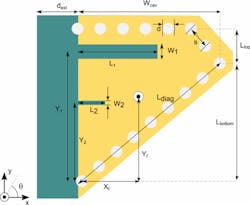Dual-ISM-Band On-Body Antenna Relies on Textiles
Textile-based wearable antennas could help to enable advanced solutions for firefighting, rescue systems, and embedded medical devices. For these antennas to avoid signal degradation and a high specific absorption rate (SAR), they often require an additional grounding structure or significant separation from the body. Recently, Sam Agneessens and Hendrik Rogier from Ghent University teamed to meet the small size, flexibility, performance, and feasibility requirements of on-body antennas. They designed and tested a half-mode-substrate integrated-waveguide (HWSIW) antenna that is capable of dual-ISM-band operation.
The antenna spans 2.4 to 2.5 GHz and 5.725 to 5.875 GHz in the industrial, scientific, and medical (ISM) bands. To meet regulatory requirements, it must satisfy certain criteria in terms of low weight, flexibility, and SAR. Other critical factors include robust electrical operation during movement, variations in body morphology, and a consistent radiation pattern. To reduce size and thus better facilitate these requirements, a cavity-backed slot antenna typology was chosen.
A virtual magnetic wall is used to compress the footprint. For more enhanced reduction, brass shorting pins are distributed evenly along the structure’s periphery. An additional slot is cut into the design to increase bandwidth at higher frequencies and fine-tune resonant behavior. The experimental results revealed a 4.9% and 5.1% measured bandwidth at the 2.4-GHz and 5.8-GHz bands. Maximum measured gains of 4.1 and 5.8 dBi were achieved. See “Compact Half Diamond Dual-Band Textile HMSIW On-Body Antenna,” IEEE Transactions on Antennas and Propagation, May 2014, p. 2374.
About the Author
Jean-Jacques DeLisle
Jean-Jacques graduated from the Rochester Institute of Technology, where he completed his Master of Science in Electrical Engineering. In his studies, Jean-Jacques focused on Control Systems Design, Mixed-Signal IC Design, and RF Design. His research focus was in smart-sensor platform design for RF connector applications for the telecommunications industry. During his research, Jean-Jacques developed a passion for the field of RF/microwaves and expanded his knowledge by doing R&D for the telecommunications industry.

